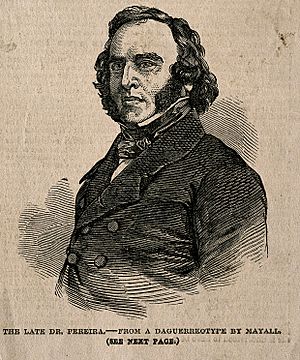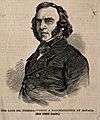Jonathan Pereira facts for kids
Jonathan Pereira (born May 22, 1804, in London – died January 20, 1853) was an important scientist who studied medicines. He wrote a famous book called Elements of Materia Medica. This book was a key guide for understanding how medicines work. He also helped test students at the University of London on this subject.
Early Life and Career
Jonathan Pereira became a pharmacist in 1823. He studied at the Aldersgate General Dispensary and St Bartholomew's Hospital. In 1826, he started teaching chemistry at the Royal College of Surgeons. By 1832, he was a well-known doctor in London. He became a professor at the Aldersgate Medical School. There he taught about materia medica and chemistry.
Later, in 1839, he moved to the London Hospital. He became an assistant doctor there in 1841. In 1842, he gave important talks at the Royal Pharmaceutical Society of Great Britain. A year later, he became a professor there. He also examined students at the UCL School of Pharmacy.
Pereira's work was like an early form of pharmacology. This is the study of how medicines affect the body. He wrote many research papers about medicines made from plants. He left his teaching role in 1852. This happened after a disagreement about his lecture notes being published without permission. After he left, another professor named Robert Bentley took over. Bentley combined the medicine lectures with his botany classes.
His Big Book on Medicines
Pereira became very interested in "crude drugs." These are natural substances used to make medicines. He noticed that not much was known about the ones brought into Britain. He spent years researching them. He learned a lot about where they came from and what they looked like.
His book, Materia Medica, was the first major English book on pharmacology. He helped make the study of medicines more scientific. He wanted people to understand how drugs worked.
In one of his first lectures, he explained materia medica. He said it had three main parts. These were:
- Pharmacognosy: The study of simple drugs.
- Pharmacy: How to prepare and use medicines.
- Pharmacodynamics: How medicines affect the body.
He used the word "pharmacognosy" to describe the study of crude drugs. This term was not widely used at the time. It took many years for it to become the official name for this subject.
Pereira encouraged his students to examine drugs closely. He taught them to use microscopes. This helped them study powdered drugs like starch. He wanted his students to check the quality of medicines. He believed this was a very important part of a pharmacist's job.
Honors and Legacy
Jonathan Pereira was recognized for his important work. He became a Fellow of the Royal Society in 1838. This is a very high honor for scientists. Two years later, he received an honorary medical degree.
After his death, a marble statue was placed in the London Hospital. The Pharmaceutical Society also created the Pereira Medal. This award and a scholarship fund are named after him. They honor his contributions to medicine.
Death
Jonathan Pereira passed away on January 20, 1853. He was buried in Kensal Green Cemetery. His monument was designed by Charles Harriott Smith.
Images for kids



